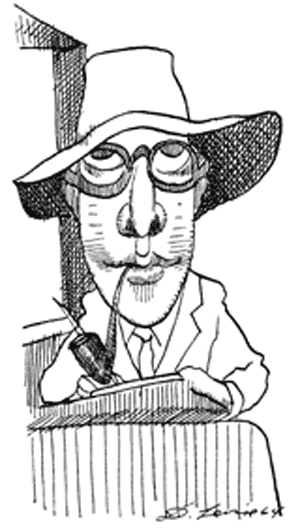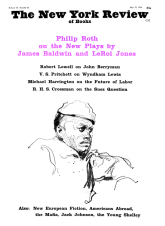There has been no period in this century so rich in works of imagination as the first thirty years; the outburst succumbed from natural exhaustion and our wars, and criticism has eaten like a frost into us ever since. It was a harsh time, whether one thinks of it as a revolutionary dawn or as a delinquent sunset. The cult of art was aggressive and given to autocratic laughter. To revisit the scene is like going over the ruins of some battle-field where grass and creepers have now grown; yet not over everything. Here and there a piece of grotesque and inconceivable iron-mongery survives in stubborn crudity—a chunk of Wyndham Lewis, perhaps. Do these old shell cases mark the site where the self-appointed Enemy’s battery blasted away? We look around at his works—Tarr, The Wild Body, The Childermass, Time and Western Man, the prolific engines of polemic, created by this energetic artilleryman. No kind mosses cover them. Unassimilated, they stick out like old blockbusting guns and abandoned tanks, fantastic without their thunder. They were built to discharge laughing anger. Why on such a scale (we ask) when the target was, as it now seems to us, so small?
“Human energy,” says Mr. Rose in his Introduction to Wyndham Lewis’s Letters, “radiates from him in awesome quantities.” That was part of Wyndham Lewis’s difficulty. The amount of awe we can stand is always limited and the Letters, though useful to the biographers, the insatiable white ants of the mass universities, and the gossips, who will pick out what was said to Augustus John Ezra Pound, T. S. Eliot, Roy Campbell, and so on, are not much help. As a letter-writer Wyndham Lewis is generally at the highest, rather monotonous pitch of an egotist’s exhilaration in his rights and wrongs. They nail Lewis down as a brilliant, touchy Welshman with a splendid power of invective and insulting laughter—in a throw-away line he called Canada “a nationetle”—an ingenious quarreler, a disarrayed commentator on public affairs—of which, portentously, he knew nothing; and give us a blurred view of his originality as an artist and of his glamour as a conspiratorial figure in literary and painting circles. He is clearly a man to beware of; he did not stab in the back. He simply mowed you down to your face with a Sten gun. In London, fortunately, this passes for eccentricity. The Letters cover his lifetime and begin very pleasantly with his childish aggressions and affections, those to his mother showing a relationship of delightful candor which is rare in Anglo-Saxon families. We move on to his period of prolific vitality as a painter, novelist, critic, and controversialist, in which he split himself deliberately into two, as the public leader of a “movement”—hostile to all comers, and into a private person who concealed himself, with famous secretiveness, from even those closest to him. He wandered about with all the air of a man blatantly spying on himself. After this, the final letters, written from the beginning of the war which he spent in the United States and Canada, until his last years in London, are depressing. America and Canada knocked the heart out of him. A natural expatriate in his own country, he faded miserably into anxious dullness when he became a real expatriate. Lonely, poor, forced to be obliging and even obsequious and to conceal his thoughts, he softened into a rather weary, overworked benevolence. It would be too much to say that he became bland, but having no friends to hit out at in the New World, his fists and biceps softened. Most immigrants explode at some point in the New World—as he observed: he was one of those who contract. He also thought that in Canada there was a provincial conspiracy against him as a great figure. He had thought the same in Bloomsbury years before, but there the idea stimulated him. In Toronto, one would gather from these Letters, he experienced the nightmare of Canadian hotel life with its awful boisterous carousing. What he thought of it all came out, with some strenuous efforts at tolerance, in Self-Condemned. He had rather overdone a naive record for the Nazis in the early Thirties—in this being no worse than many respectable politicians, or those who over-praised the Communists—and these wartime letters show anxiety to establish that he had changed his mind. It is notable that the life long friends of the expatriate—T. S. Eliot, Ezra Pound, and Roy Campbell—were themselves expatriates.
Wyndham Lewis’s last years in London were, once again, productive. He did some interesting work—the little book attacking the idea of progress in the Arts and the new volumes of The Human Age: and by a stroke of luck, a very perceptive producer in the B.B.C. realized that Lewis’s theatricality concealed a real sense of the theatrical. Very hard to read, one page annulling its predecessor, The Human Age was transformed when one listened to it as “spoken word.” His machine images, his hilarious gift of treating human beings and ideas as things, his Welsh-Germanic sense of the grotesque, his block-busting visual words, were meant to be heard, not read. Joyce was too. The cluttered prose came into its own. One thinks of Dylan Thomas and realizes that both were making use of the euphoric Welsh gift for invoking giants and giantesses. Even Meredith had it too. The satire, and jokes and encumbrances in Wyndham Lewis are much better understood in that context, than in the context of the terrasse life of art movements in Munich, Paris, and Charlotte Street. It is worth remarking that the stories of The Wild Body are the result of his cousinly observations in Britanny.
Advertisement
As T. S. Eliot once or twice warned him, Lewis’s weakness was that he could not stop scattering his powers and could not control a brilliant, spluttering brain. Of course, it is better to be a painter turned talking writer, than to be a writer turned painter; but the painter’s danger, in prose, is that he will plaster one brush load of visual stuff on to another and that the result will be static. That is the curse of Lewis’s more ambitious experimental satire. He lives excessively by the magnetizing eye.
Yet it was the theory of the Eye allied to a mixture of anger and sanity, that is the making of his one totally successful book: Tarr. This novel still seems to me to be one of the considerable comic novels of the last forty years. In parts, it harks back to Smollett. It outdoes anything in Joyce in the way of physical description and especially of the grotesque. It is marvelously inventive without killing its own inventions. In two scenes, the dance and the duel, it is superb in its outrageous comedy and its comic disrespect for the human body and heart. For Kreisler, the absurd Hitler-like painter perceived long before his time, “women were vast dumping grounds for sorrow and affection.” A dancer is described:
A rather congested, flushed, bespectacled young woman her features set in a spasm of duty. It was a hungry sex in charge of a flustered automation.
A girl’s bubbling lips “refuse no emotion noisy egress if it got so far.” Wyndham Lewis had something of Smollett’s butchering humor, but the laughter is not the laughter of hypochondria, nor of continuous hate: it bursts out and ends on a note of relieving sanity. Tarr can be read; it does not need to be spoken. It is written not painted. It is a young man’s book.
In the legally stuffy Twenties, Lewis’s satires brought him into difficulties with the severe English laws of libel. The Letters have some references to these troubles, especially with regard to The Apes of God. It strikes one now that Lewis’s targets were too small for such heavy gunfire. His famous persecution mania was a nuisance to himself and others; but one has to see it as part of the peculiar psychological apparatus that produced his giants of folly. It made his imagination macroscopic. He was not a sensitive man, indeed he hated sensibility. Intelligence was his mania. He was, despite all the Experimentalism, close in feeling to the mid-eighteenth century and it would probably have annoyed him to hear that said. In the Letters one also finds occasional scraps of travel or topical observation that made him a vigorous journalist. But here, too, he was apt to be caught like a gramophone needle in his own violent headlines, so that the graphic became repetitious. Yet, in its exhibitionist way Filibusters in Barbary can still be read as a slap-dash work of travel. The Eye does its work. The final disaster of his life had an atrocious symbolism in it: the Eye failed him. He went blind and a tumor on his over-charged brain killed him.
This Issue
May 28, 1964




